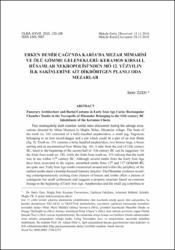| dc.contributor.author | Özer, Bekir | |
| dc.date.accessioned | 2020-11-20T14:43:35Z | |
| dc.date.available | 2020-11-20T14:43:35Z | |
| dc.date.issued | 2019 | |
| dc.identifier.issn | 1301-7667 | |
| dc.identifier.uri | https://hdl.handle.net/20.500.12809/1205 | |
| dc.description | WOS: 000467807800006 | en_US |
| dc.description.abstract | Two rectangularly built chamber tombs were discovered during the salvage excavations directed by Milas Museum in Mugla, Milas, Husamlar village. The finds of the tomb no. 342 consisted of a belly-handled amphoriskos, a small jug, fragments belonging to an iron sword/dagger and a pin which could be a part of an iron fibula (fig. 9). Tomb no. 351 contains a belly-handled amphoriskos, two bronze rings, a bronz earring and an asymmetrical bow fibula (fig. 10). A date from the end of 12th century BC, latest to the beginning of the second half of 11th century BC can be suggested for the finds from tomb no. 342, while the finds from tomb no. 351 indicate that the tomb was in use within 11th century BC. Although several tombs from the Early Iron Age have been excavated in the region, unearthed tombs from 12th and 11th centuries BC are quite rare. Early Iron Age tombs constructed around and within the periphery of the earliest tombs attest a kinship-focused funerary practice. The Husamlar evidence revealing contemporaneously existing close clusters of houses and tombs offers a picture of contiguous but small settlements and suggests a property structure based on common lineage in the beginning of Early Iron Age. Amphoriskoi and the small jug contribute to the understanding of local features of ceramics of Coastal Caria and its hinterland along with finds from Comlekci, Pedasa and Asarldc/Tennera. Slow-wheel production in the vast majority, biconical and angular profiles, irregular rows of bands, clumsy decoration and thick walls are the common features of the local pottery with Mycenean influence dating to the 12th and the first half of the 11th centuries BC. Myceanean traits observed in the general characteristics of fmds reveal the fact that Caria is in fact an important part of the East Aegean Koine. The first examples of rectangularly built Early Iron Age chamber tombs discovered in the excavations of comlekci and Husamlar do not seem to have any Late Bronze Age predecessors in South-Eastern Aegean mainland. The fact that similar grave type has been used in mainland Greece and Aegean islands in the Late Bronze Age and the characteristics of the fmds suggest that people using these tombs must be related to the world of the Aegean culture. Considering these facts along with a society practising inhumation and multiple burials, it is likely that Husamlar and comlekci people kept the late Bronze Age habits alive. In this paper, it is suggested that refugees/settlers from nearby or relatively further regions have chosen areas as Comlekci and Husamlar located just beyond the coast to settle during the chaotic and unstable environment of the 12th century BC. If this is the case, they might have preferred the rectangular built chamber tombs that they were accustomed to. Early Iron Age diffusion of rectangular built chamber tombs offer a possible chronological picture regarding the expansion of people using this type of tombs. They have become the most common grave type in Mylasa, inner Caria, spesifically Stratoniceia and environs along with the Keramos chora and comlekci by the 8th century BC. | en_US |
| dc.item-language.iso | tur | en_US |
| dc.publisher | Mersin Univ Publ Res Center Cilician Archaeology | en_US |
| dc.item-rights | info:eu-repo/semantics/openAccess | en_US |
| dc.subject | Caria | en_US |
| dc.subject | Husamlar | en_US |
| dc.subject | LH III C | en_US |
| dc.subject | Early Iron Age | en_US |
| dc.subject | Rectangular Built Chamber Tomb | en_US |
| dc.subject | Refugees | en_US |
| dc.title | Funerary Architecture and Burial Customs in Early Iron Age Caria: Rectangular Chamber Tombs in the Necropolis of Husamlar Belonging to the 12th century BC Inhabitants of the Keramos Chora | en_US |
| dc.item-type | article | en_US |
| dc.contributor.department | MÜ, Edebiyat Fakültesi, Arkeoloji Bölümü | en_US |
| dc.contributor.institutionauthor | Özer, Bekir | |
| dc.identifier.volume | 27 | en_US |
| dc.identifier.startpage | 133 | en_US |
| dc.identifier.endpage | 168 | en_US |
| dc.relation.journal | Olba | en_US |
| dc.relation.publicationcategory | Makale - Uluslararası Hakemli Dergi - Kurum Öğretim Elemanı | en_US |


















